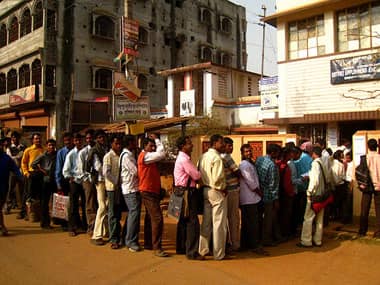The last polio case in India was detected on 13 January 2011 at Howrah in West Bengal. It has taken just 16 years of mass vaccination and immunization for the disease to be erased. From an estimated 500 cases of polio every day before 1978, the number dropped to 2,000 a year after 1995 when an eradication campaign was launched in mission mode.
Next year the 5,000 km range Agni-V nuclear-tipped inter-continental ballistic missile might be inducted into the defence forces. In 1989, the first Agni missile with a range of 700 km was test fired at Chandipur in Orissa. India had defied Western sanctions and very restrictive technology denial regimes to develop the missile with its own ingenuity.
I have given the above examples to prove only one point. When the government is committed to a “mission”, it gets it done. QED.
[caption id=“attachment_74853” align=“alignleft” width=“380”]  Let’s pray that the next government launches a second freedom struggle - to create jobs and end poverty - by launching a manufacturing satyagraha. Getty Images[/caption]
Unfortunately, our political leaders need the veneer of “poverty” or “national security” to put things on mission mode - then it becomes politically profitable to flaunt these “noble objectives”. But anything to do with the creation of wealth or industry or jobs is seen as too elitist. This is a shame.
Our politicians must understand that the country is on the brink of an once-in-a-lifetime opportunity, which, if not harnessed, could become a terminal debacle. I am talking about the demographic dividend which requires India to create nearly 40,000 jobs every day, day after day, for the next 10 years. Clearly, only large scale manufacturing can deliver on this awesome challenge. As opposed to the wasteful MNREGS, we need a Mahatma Gandhi National Manufacturing Mission.
Hey, maybe I’ve just stumbled on a smart political idea - prefix the Mahatma’s blessings on to “India’s manufacturing mission”, and perhaps our politicians would begin to scream its pro-poor credentials!
More seriously, India must raise the share of manufacturing in GDP to 30-35 percent by the end of this decade. It has hovered at 16 percent for the past ten years (and could be shrinking). This is much lower than it was in fast-growing East Asian economies at our stage of development. Predictably, the government’s visible action has been to set up a committee. The National Manufacturing Competitiveness Council, headed by the very capable corporate leader, V Krishmurthy, gave a strategy report in 2006. That same year the first special economic zones came up as manufacturing enclaves free of friction - infrastructural and regulatory - that frustrated activity outside them. But the Communists did not allow labour laws to be relaxed while ensuring the passage of SEZ legislation; the zones also became tiny-sized real estate grabs and ran into popular opposition.
The Economic Survey of 2012-13 had a chapter on why business was not creating more productive jobs. Unlike in the United States where surviving start-ups grow spectacularly, small enterprises in India are incentivized to stay small - like no service tax for less than Rs 1 cr turnover, or no central excise duty up to Rs 1.5 cr revenue. Consequently, there are too many tiny businesses employing less than 10 persons (85 percent in the apparel industry, for example); medium enterprises are near non-existent. Ninety-five percent of workers are in the informal sector or work in the formal sector without social security. It is critical, therefore, to change such perverse “concessions” that force entrepreneurs to open several “small” units instead of building a unified large scale operation. We also need an intermediate structure of employment that can be made politically acceptable through fair severance packages, unemployment insurance and provision for reversal of unfair dismissals.
Unfortunately, while there is little political consensus on relaxing labour laws, both the NDA and UPA governments have done little to create it. The ministers heading labour ministries have not been reformers, nor have they been political movers and shakers. None has bothered to implement the sensible Second Labour Commission recommendations of 2002, which advised that enterprises should be allowed to lay off workers partly or wholly, by paying graded compensation depending on whether downsizing is for revival of an enterprise or whether the layoffs are forced by business distress.
Since a consensus will take time to forge, the next government must (so the Survey suggests) give states the freedom to experiment and allow such flexibility in labour laws as does not conflict with central laws. There is evidence that states that have less stiff labour laws score high on labour productivity.
Finally, the new land acquisition law will have to be practically amended. Since it may not be politically feasible to reduce the 2- or 4-times price multiple, at least the crippling array of permissions and social impact surveys can be drastically pruned. The demise of these rent creating rules should not rile up political opposition, especially if the price multiple stays intact.
Let’s pray that the next government launches a second freedom struggle - to create jobs and end poverty - by launching a manufacturing satyagraha.


)
)
)
)
)
)
)
)
)



